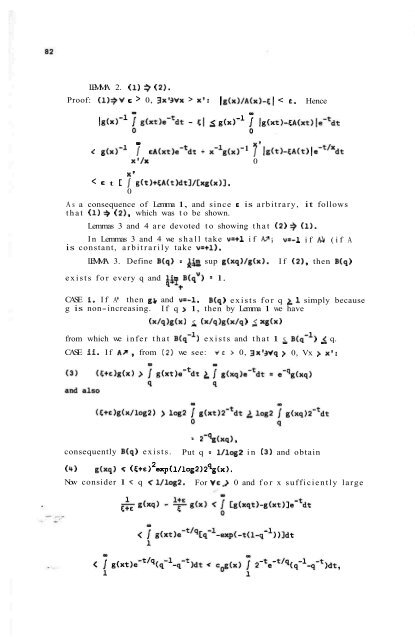Create successful ePaper yourself
Turn your PDF publications into a flip-book with our unique Google optimized e-Paper software.
LEMMA 2. (1) 3 (2).Proof: (l)z$V e > 0, 3xWx > x': Ig(x)/~(x)-Sl < e. Hencem< g(x)-l / eA(xt)e^dt + x-lg(x)- / ~g(t)-S~(t)1x'/x 0x'< E t [ / g(t)+€A(t)dtl/[xg(x)0le-^dtAs a consequence of Lemma 1, and since e is arbitrary, it followsthat (1) +p (2). which was to be shown.Lemmas 3 and 4 are devoted to showing that (2) =) (1).In Lemmas 3 and 4 we shall take u=+l if ATI;is constant, arbitrarily take v=+l).LEMMA 3. Define B(q) = A^jg sup g(xq)/g(x).exists for every q and 14 BtqU) = 1.q 5.u=-1 if Alf (if AIf (2). then B(q)CASE i. If A* then gs, and v=-1. B(q) exists for q 21 simply becauseg is non-increasing. If q > 1, then by Lemma 1 we have(x/q)g(x) < (x/q)g(x/q) < xg(x)from which we infer that ~(q-) exists and that 1 $, BC~") A q.CASE ii. If A/*, from (2) we see: VE > 0, 3x'aVq > 0, Vx > x':2by (4). where c=(C+l) exp(l/log2).Divide this by g(x), take thelim sup as x-, the limit as E+O, and note that g?I. This results in-2 -1/q1 S, B(q) 1 + 2coq(l-qlog2) e log q.The lemma follows immediately.LEMMA 4. Define CL and CH respectively as $^jg inf andA(x)& sup of ^y ; then (2) CL ^, 1/â 2 CH. In the interest of brevityonly the firstinequality willbe shown in full detail, the proof ofthe second is conceptually the same.Proof: Consider an arbitrary q (1 < q < l/log2). Define ~ ( t = ) 4(2-t-2-2t)and select an N > 2, then set H(t ) = pN(t and h(t) = H(t ) -~~-'~tt)where 0=0(q) = maxfp(q-l),p(q)}.obviously 0 < 1. FurthermoreSince p(t)+ (O&ts) and p(t)+ (ts),R(5) H(t) and h(t) are both of the form 1 vre-tvr (or > 0).r=l(6) H(t) 0 (t20) and h(t) ^, { H(t) (tk0)0 tl'cq-l,q)'For an additional ease of notation also defineIt follows from (6) that(7) 0 < J(x) > J (x) > j (x) 2 j(x).q qIt will be clear that (8) through (13) hold for any particular e > oif x is sufficiently large. <strong>No</strong>w observe thatconsequently B(q) exists.= 2-^cxq),Put q = l/log2 in (3) and obtain(4) g(xq) < (~+e)~exp(l/log2)2qg(x).<strong>No</strong>w consider 1 < q 0 and for x sufficiently largewhere c= 4[~(~~~/lo~2)+l]/lo~2 > 0. In view of (7), this leads to
















